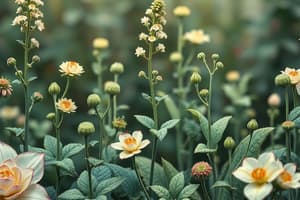Podcast
Questions and Answers
What is the main focus of economic botany in relation to medicinal plants?
What is the main focus of economic botany in relation to medicinal plants?
- The classification of plants based on their habitats
- The economic significance and modern applications of medicinal plants (correct)
- Only the botanical properties of plants
- The historical uses of all types of plants
Which of the following plants is not categorized as a sugar-yielding plant?
Which of the following plants is not categorized as a sugar-yielding plant?
- Neither A nor B
- Sugar beet
- Maize (correct)
- Sugarcane
What does heterosis refer to in plant breeding?
What does heterosis refer to in plant breeding?
- The genetic uniformity of a crop
- The detrimental effects of using native plants
- The gradual decline of plant species
- The ability of hybrid plants to outperform their parents (correct)
Which of the following is a focus in the study of plant breeding?
Which of the following is a focus in the study of plant breeding?
Which type of breeding system involves both self and cross-pollination methods?
Which type of breeding system involves both self and cross-pollination methods?
Which plant is known for its medicinal properties, specifically its role in traditional medicine?
Which plant is known for its medicinal properties, specifically its role in traditional medicine?
Which of the following is an effect of inbreeding depression in plants?
Which of the following is an effect of inbreeding depression in plants?
What does acclimatization in plant breeding refer to?
What does acclimatization in plant breeding refer to?
Flashcards
Centres of origin
Centres of origin
Geographical areas where crop plants originated and diversified.
Plant Breeding
Plant Breeding
Improving crop plants through selective breeding techniques.
Economic Botany
Economic Botany
Study of economic uses of plants, including food, medicine, fibers, etc.
Hybridization
Hybridization
Signup and view all the flashcards
Inbreeding Depression
Inbreeding Depression
Signup and view all the flashcards
Heterosis
Heterosis
Signup and view all the flashcards
Plant Genetic Resources
Plant Genetic Resources
Signup and view all the flashcards
Domestication
Domestication
Signup and view all the flashcards
Study Notes
Course Outcomes
- Understand the importance of medicinal plants and their uses, including traditional remedies, in everyday life
- Learn about plant breeding systems, heterosis, and mutations
Unit 1: Origin of Cultivated Plants
- Explore the concept of centers of origin and their significance, based on Vavilov's work
- Understand the origin of cultivated plants
Unit 2: Botany and Commercial Utilization
- Key crops include cereals (wheat, rice, maize, ragi, pearl millet), sugar-yielding plants (sugarcane, sugar beet), fruits (mango, apple, banana, citrus, litchi), fibers (cotton, jute, hemp, coir, agave, semal), vegetables (root, stem, fruit), timber (teak, shisham, sal, chir, deodar) and medicinal plants (aconitum, atropa, cinchona, rauwolfia, ephedra, withania, aloe vera), oils, beverages, masticatories, spices, and condiments
Unit 3: Plant Breeding
- Define plant breeding, its objectives, and different breeding systems
- Highlight notable achievements and potential drawbacks in plant breeding
- Introduce methods for crop improvement, including centres of origin and domestication
- Discuss plant genetic resources, acclimatization, and selection methods
- Detail the role of hybridization, emphasizing self-pollination, cross-pollination and vegetative propagation, including advantages and limitations associated with each method
- Explain the importance of inbreeding depression and heterosis
- Discuss the role of mutations and polyploidy in crop improvement, together with the role of biotechnology
Unit 4: Hybridization and Biotechnological Improvement in Plant Breeding
- Explore hybridization techniques in self-, cross-pollinating, and vegetatively propagated plants
- Analyze the advantages and disadvantages of different techniques
- Detail the concept of inbreeding depression and heterosis, their genetic basis, and applications in crop improvement
- Explain the role of mutations and polyploidy in plant breeding
- Discuss the role of biotechnology in crop improvement
Suggested Readings
- Kochhar, S.L. (2011). Economic Botany in the Tropics. MacMillan Publishers India Ltd.
- Pandey, B.P. (1999). Economic Botany. S. Chand, New Delhi
- Singh, B.D. (2005). Plant Breeding: Principles and Methods. Kalyani Publishers
- Acquaah, G. (2007). Principles of Plant Genetics and Breeding. Blackwell Publishing
Studying That Suits You
Use AI to generate personalized quizzes and flashcards to suit your learning preferences.




